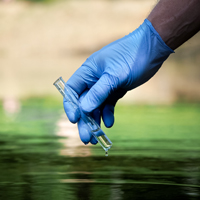MENU
- Home
- Overview
- Attorneys
- Practice Areas
- Firm News
- Blog
- Contact
 The Dover Air Force Base is among several local military sites that have extraordinarily high levels of ground water contamination from two perfluorocarboxylic acids (PFCs). Measurements of two such chemicals, PFOA, a perfluorocarboxylic acid, and PFOS, a perfluorosolfonate, were as high as 254,000 times the limit of 11 parts per trillion (ppt), which one Federal agency deems necessary for drinking water to protect public health.
The Dover Air Force Base is among several local military sites that have extraordinarily high levels of ground water contamination from two perfluorocarboxylic acids (PFCs). Measurements of two such chemicals, PFOA, a perfluorocarboxylic acid, and PFOS, a perfluorosolfonate, were as high as 254,000 times the limit of 11 parts per trillion (ppt), which one Federal agency deems necessary for drinking water to protect public health.
Two sites near Wilmington had similar results. New Castle Air National Guard Base was tested at 758 times the recommended limit while the Marine Corps Reserve Training Center was tested at 176 times the recommended limit. The findings were made available by the Union of Concerned Scientists (UCS), a non-profit science-based organization, who performed a study of PFC contamination detected by the Department of Defense at military sites.
PFCs are used in many products. It is likely the Dover Air Force Base and other military sites were contaminated by using firefighting foam containing PFOA. There is reason to be concerned about the high level of contamination. Once contamination reaches the ground water, it can spread in a plume and affect nearby public water systems and private wells.
Efforts are being made to reduce use of PFOA and PFOS to warn the public about the potential threat. There is widespread use of these compounds. They are suspected of causing fetal damage, kidney and testicular cancer, liver damage, immune system interference, thyroid malfunction, and elevated cholesterol levels. Some advocates, including the UCS, believe more needs to be done to protect public health and the environment.
The U.S. Environmental Protection Agency (EPA) has found PFCs in some local drinking water supplies and found that PFCs have begun to bioaccumulate in fish. The EPA has also evaluated peer reviewed research on toxicity of PFCs. Considering the evidence, the EPA published a Lifetime Health Advisory (LTHA) for PFOA and PFOS. They recommend that the concentration of PFOA and PFOS in drinking water, either individually or combined, should not be greater than 70 ppt.
The LTHA is non-regulatory and simply provides technical information on health effects, analytical methodologies, and treatment technologies associated with drinking water contamination. The agency is considering whether it is necessary to regulate PFOA and PFOS at the national level. It has held public hearings at certain contaminated sites.
Another regulatory agency is recommending a different value for safe drinking water levels. The Agency for Toxic Substances and Disease Registry (ATSDR) issued a report proposing the safe drinking water limit be set at 11 ppt, which is much stricter than the EPA’s recommendation.
If you believe you have been exposed to dangerous levels of a toxic chemical, do not wait until you feel sick to act. An experienced Delaware environmental lawyer at Jacobs & Crumplar, P.A. can help assess your situation. Call us at 302-656-5445 or complete our online form for a free initial consultation. With offices in Wilmington and Georgetown, Delaware, we serve clients from the surrounding areas, including Dover, New Castle County, and Sussex County.